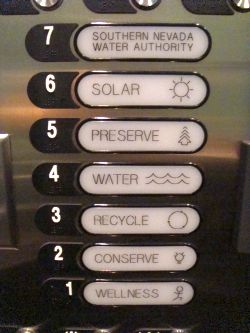
This is a guest post by my travel partner, Todd Dwyer, head blogger for Dell’s ReGeneration.org.
—–
When you think of Las Vegas, a lot of things may come to mind, but sustainability probably isn’t one of them. The city is the fastest growing in the United States, and has built its reputation on achieving what previously seemed impossible. Building a city-sized oasis capable of sustaining a huge population in the middle of the Nevada desert is an impressive feat, but I must admit that the very act of doing so seems, well, unnatural. So I was pretty skeptical about the “green” stops we had planned. How can a city that defines itself on luxury and excess possibly hope to become an environmentally responsible destination for its residents and visitors?

I am happy to report that the green movement is alive and well in Sin City, and what I have learned here has changed my opinion of the city itself and given me hope for our future. In addition to our stops at the Palazzo Hotel-Resort (the world’s largest LEED-certified building), and Nellis Air Force Base where North America’s biggest PV solar array resides, Sarah and I stopped by the Union Park neighborhood development to have a chat with Rita Brandin, the development director for Newland Communities, the group overseeing this ambitious project.
Once completed, Union Park will be a model for sustainable and stylish neighborhoods throughout the country. Built on a fallow brownfield once used by Union Pacific Railroad as a fuel depot and evaporation pond, the 61 acres currently being developed will see new life as Nevada’s only neighborhood accepted into the LEED Neighborhood Development national pilot program. This means that it will not only employ the greenest materials and practices currently available, but will also be located in the heart of the city, easing the area’s dependence on auto traffic. Traffic engineers expect this easy linkage to the community at large to cut the future resident’s car trips by a third per day.
Here’s Rita talking to us about the project and what it means for the city:
It should also be noted that this neighborhood will be the future home of the city’s first and only performing arts center.
While we were waiting on our appointment with Rita, Sarah and I dropped into the Molasky Corporate Center — also built on land abandoned by Union Pacific — for some much needed coffee. We were happy to discover while we were there that the building is LEED-Gold certified. Here are some pictures we took as we sipped our liquid inspiration and strolled about the center:


So I’m forced to admit that my skepticism of the city was ill-founded. There is hope yet for all of us — because if a city like Las Vegas can become a showcase for sustainable and responsible practices, truly anywhere can.

